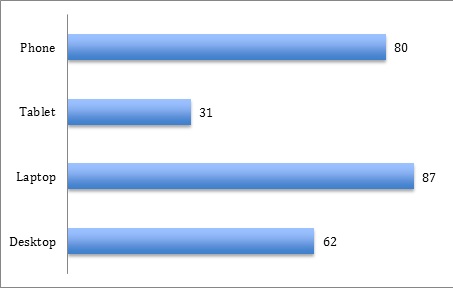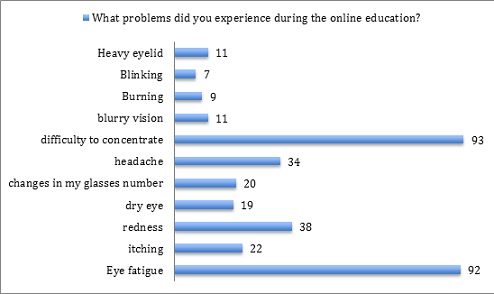
Eye Symptoms in Online Education, During Pandemic Period: A Cross Sectional Study
*Corresponding Author(s):
Marsida KrasniqiDepartment Of Medical Sciences, University Aleksander Moisiu, Durres, Our Lady Of Good Counsel, Tirana, Albania
Email:linditaagolli07@gmail.com
Abstract
Albania as well as many countries of the world during the time of pandemic Covid-19 was lockdown to prevent the spread of the virus in the population. Universities were closed to maintain social distance, but teaching was conducted online. Online teaching continued for more than 1 year. The aim of our study was to determine eye problems during online learning in students who participate in this study. This study is a cross sectional study, with a self-completion questionnaire. Students have completed the questionnaire that was sent to them by email. 581 students completed the questionnaire about demographic data, use of digital devices and the symptoms they had experienced while learning online. The data were collected and analyzed. From the results obtained it was evidenced that more than 80% of students spent more than 5 hours during the day in online learning. Most of them used laptops and phones as digital tools to attend online learning. Regarding ocular problems, 76% of them answered that they had symptoms while using digital tools. 93% of them had difficulty to concentrate during online learning and 92% had eye fatigue. Less than 20% of them answered heavy eyelid, blurry vision, dry eye and blinking. In conclusion we can say that the use of digital tools does not affect ocular health. The development of online learning will become a normal part of teaching policies by changing the trend of education among young people.
Keywords
Online education; Eye problems; Covid-19 pandemic; Albania
Introduction
During the Covid-19 pandemic period, which affected the whole world, Albania took measures to close the country in order to prevent as much as possible the spread of the virus. Schools and universities in Albania were closed after being considered a risk for the spread of the virus. The lockdown of the country took place in March 2020, when the first two cases of covid-19 were identified. As in any other country in the world even in Albania the learning took place online through systems Zoom, Moodle and Teams. The lockdown period was more than 1 year, and the close of schools and universities lasted until October 2021. During this period students continued learning normally with the online learning system. The aim of our study is to identify the ocular problems that students have had during their online leaning time.
Methods
This is a cross sectional study that was conducted in a period of 2 months, from October 18, 2021 to December 20, 2021. A self- completion questionnaire was sent to the students to complete by their email. The format of the questionnaire was made in “google form”. The students who participated in this study were the students of Aleksander Moisiu University in Durres and the students of Sport University in Tirana. The questionnaire was constructed with 11 closed questions where in demographic data; details about the use of digital devices and symptoms they had experienced during the online learning were obtained. The questionnaire with 11 closed questions in “google form” was sent to 1022 students by email, out of which a total of 581 students answered. 332 (57%) students were from Aleksander Moisiu University and 249 (43%) students were students from Sport University. Data were collected and analyzed by SPSS. Data were presented as mean, standard deviation and percentage.
Results
In table 1 we have presented the demographic data of students who participated in the study and details about the use of digital devices during online learning period. The average age of the students who participated in the study was 19.01±2.6 years, where 54% of them were female and 46% male.
|
Mean age |
19.01 ±2.6 |
|
Gender |
Nr. (%) |
|
Male |
269 (46) |
|
Female |
312 (54) |
|
Total |
581(100) |
|
Frequency of online learning |
|
|
Never |
0 (0) |
|
Once a week |
40 (7) |
|
2-3 time a week |
93 (16) |
|
Once a day |
163 (28) |
|
Multiple times a day |
285 (49) |
|
Time spent on online learning |
|
|
< 5 hour/day |
302 (52) |
|
> 5 hours/day |
279 (48) |
|
Watching record lesions |
|
|
Never |
52 (9) |
|
Once a week |
122 (21) |
|
2-3 time a week |
331 (57) |
|
Once a day |
64 (11) |
|
Multiple times a day |
12 (2) |
|
Watching live class |
|
|
Never |
0 (0) |
|
Once a week |
6 (1) |
|
2-3 time a week |
46 (8) |
|
Once a day |
76 (13) |
|
Multiple times a day |
453(78) |
|
Interacting with teacher |
|
|
Never |
0 (0) |
|
Once a week |
0 (0) |
|
2-3 time a week |
29 (5) |
|
Once a day |
221 (38) |
|
Multiple times a day |
331 (57) |
|
Does you feel changes in your eye health after the use of online education? |
|
|
Yes |
442 (76) |
|
No |
139 (24) |
Table 1: Demographic data and details about the use of digital devices.
From data collected, 48% of students answered that they spent more than 5 hours a day with online learning and 57% answered that they watched recorded lesions 2-3 times a week. The interaction with teacher was reported by multiple times a day by 57% of students.
To the question if they feel any changes in their eye health after the use of online education, 76% of them answered yes.
In graph 1 we have represented the percentage of the use of digital devices among students. Most of them used laptop (87%) and phone (80%) to attend online learning.
 Graph 1: Presentation in percentage of the use of digital devices among students.
Graph 1: Presentation in percentage of the use of digital devices among students.
Tablet and desktop were other digital devices used by more than 50% of students. One student had used more than one digital device to attend the online learning.
In graph 2 we have presented the prevalence of ocular symptoms that students have felt while using digital devices to attend online learning. The most common symptoms they experienced were difficulty to concentrate in 93% of them, eye fatigue in 92%, followed by redness of the eyes and headache.
 Graph 2: Prevalence of ocular symptoms during online learning.
Graph 2: Prevalence of ocular symptoms during online learning.
Less than 10% of students answered for blinking and burning. Only 20% of students answered for changes in glasses number during the online learning.
Discussion
Albania lockdown affected not only the economy but also the psychology and social life of people. Social distance was one of the ways to prevent the spread of covid-19 [1]. In Albania as in other part of the world the schools and universities continued teaching through digital online learning through various platforms such as zoom moodle and teams [2]. In Albania online learning started in March 2020 and lasted until October 2021. In this study we considered reasonable to evaluate the effect that the use of digital devices had on eye health. Other studies have been investigated about the impact of online learning and eye health [3,4].
In this study we found that more than 50% of students studied more than 5 hours a day online and over 90% of them had experienced ocular problems. Other students in other studies around the world had reported ocular problem during online learning during pandemic [3,5].
The most digital devices used for teaching in our study were laptops and telephones in over 80% of students. Also most of them responded that they had used more than one digital tool during online learning. In other studies desktop and laptops were the most used devices for online learning [2].
The most common ocular symptoms experienced by students in our study were difficulty to concentrate and eye fatigue, followed by redness and headache. Other studies have identified eye stain as a symptom during online learning [6]. Other has reported difficulty to concentrate [7].
In conclusion, we can say that the use of digital devices for more than a year, did not affect eye health. The development of online learning in the near future will become a normal part of teaching policies by changing the trend of education among young people in Albania.
Limitations
Since this study included the students of Aleksander Moisiu University of Durres and students of Sports University of Tirana, the data are only for this population group. A more detailed and multicenter study would better determine the symptoms experienced while learning online during pandemic period. However our study was a quantitative study; the data suggested that students while using digital devices had difficulty to concentrate and eye fatigue.
Declaration of Conflicting Interest
The authors declare that they have no conflict of interest.
References
- Glogowsky U, Hansen E, Schächtele S (2021) How effective are social distancing policies? Evidence on the fight against COVID-19. PLoS ONE 16: 0257363.
- Mishra L, Gupta T, Shree A (2020) Online teaching-learning in higher education during lockdown period of COVID-19 pandemic. International Journal of Educational Research Open 1: 100012.
- Kaya H (2020) Investigation of the effect of online education on eye health in Covid-19 pandemic. International Journal of Assessment Tools in Education 7: 488-496.
- Fahima Sheerin SMH, Divya S, Chindhiha S, Vincy S, Chandrasekar M, et al. (2021) Newborn screening by enzyme immunoassay using dry blood spot for diagnosis of metabolic disorders. International Journal of Medical Science and Public Health 10: 1.
- de Santana JM, de Melo CB, Gaete MIL, de Carvalho GSL (2019) Doença Inflamatória orbitária associada a IgG4: Relato de caso. E Oftalmo 5: 68-70.
- Gantz L, Rosenfield M (2021) Digital eye strain symptoms during online university learning in Israel and the USA during the COVID-19 pandemic. Investigative Ophthalmology and Visual Science 62: 1975.
- Özüdogru G (2021) Problems faced in distance education during Covid-19 Pandemic. Participatory Educational Research 8: 321-333.
Citation: Krasniqi M (2023) Eye Symptoms in Online Education, During Pandemic Period: A Cross Sectional Study. J Ophthalmic Clin Res 10: 110.
Copyright: © 2023 Marsida Krasniqi, et al. This is an open-access article distributed under the terms of the Creative Commons Attribution License, which permits unrestricted use, distribution, and reproduction in any medium, provided the original author and source are credited.

